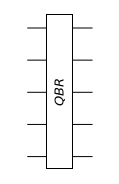Apart from the above mentioned quantum factorization algorithm, the quantum Fourier transformation is a key part of many other quantum algorithms, such as the quantum phase estimation, the order-finding problem, the discrete logarithm, and most importantly the hidden subgroup problem. Such a wide range of applications of the quantum Fourier transform stems from the fact that all known quantum algorithms featuring an exponential speedup over classical algorithms are variations of the hidden subgroup problem and, as first realized by Kitaev (1996), the key step to solve the latter problem is the quantum Fourier transform.

